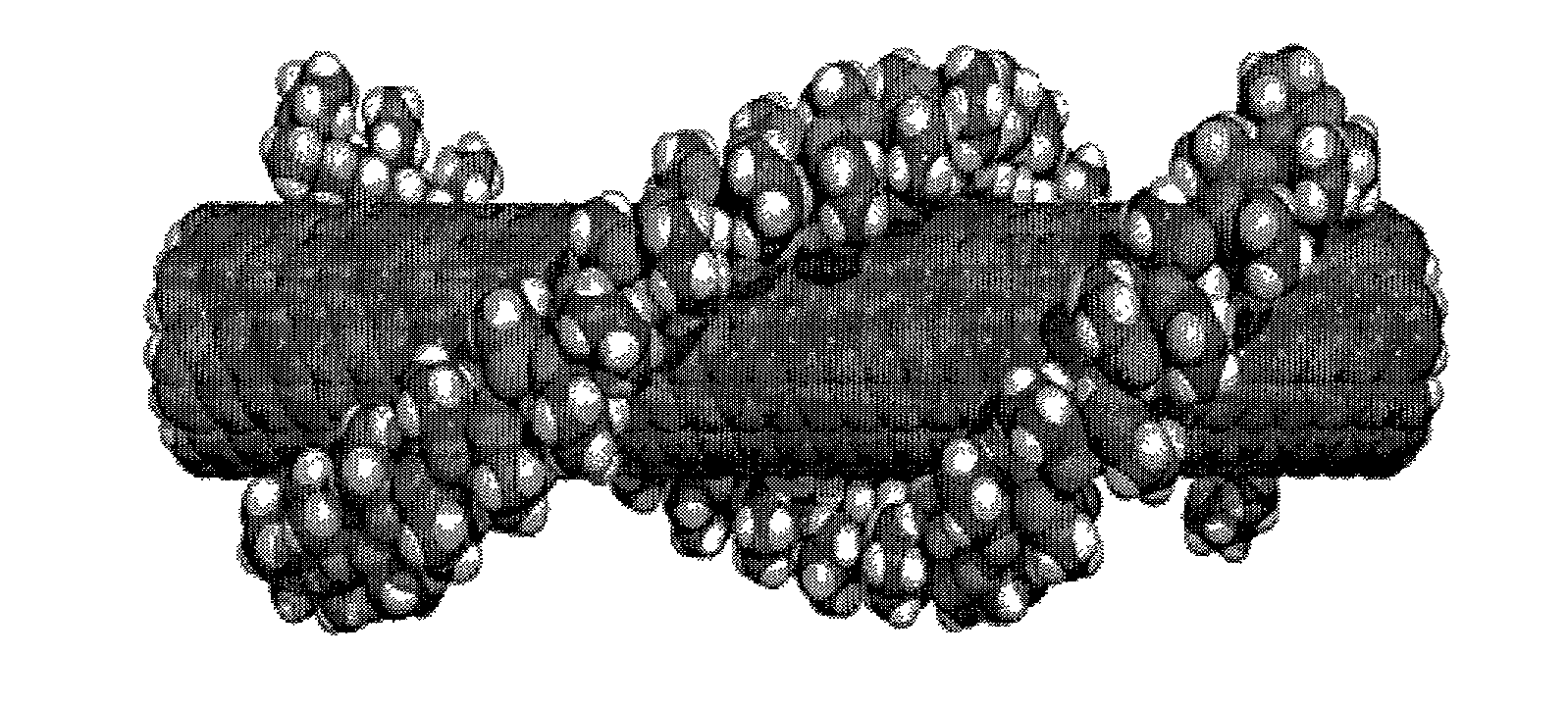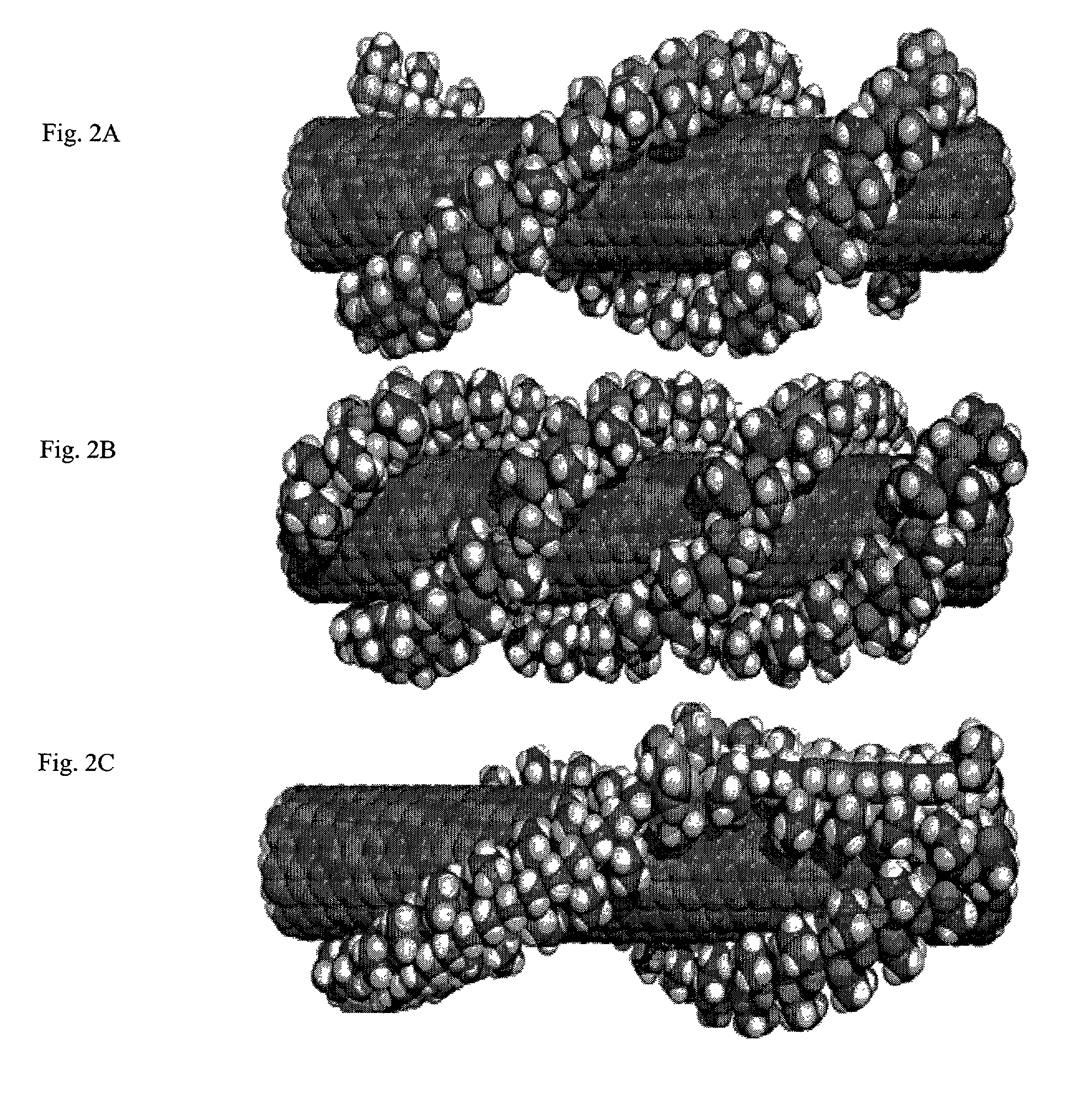Polymer-wrapped single wall carbon nanotubes
a carbon nanotube and polymer technology, applied in the field of carbon nanotubes, can solve the problems of difficult separation of individual carbon nanotubes from the other reaction products, low nanotube yield, and high absorption efficiency, and achieve the effect of high absorption efficiency and new behavior
- Summary
- Abstract
- Description
- Claims
- Application Information
AI Technical Summary
Benefits of technology
Problems solved by technology
Method used
Image
Examples
example 1
Suspension
[0059]Material is first purified to remove catalyst and amorphous carbon. See “Large-scale purification of single-wall carbon nanotubes: process, product and characterization,” A. G. Rinzler, J. Liu, H. Dai, P. Nikolaev, C. B. Huffman, F. J. Rodriguez-Macias, P. J. Boul, A. H. Lu, D. Heymann, D. T. Colbert, R. S. Lee, J. E. Fischer, A. M. Rao, P. C. Eklund, R. E. Smalley, Applied Physics A, 67, 29 (1998)) and provisional U.S. patent application 60 / 268,228, entitled “Purified Single-Wall Carbon Nanotubes” filed Feb. 12, 2001, and provisional U.S. patent 60 / 284,419, entitled “Method for Purifying Single-Wall Carbon Nanotubes and Composition Thereof,” filed Apr. 17, 2001, both of which are incorporated herein by reference in their entirety. The SWNT material is then dispersed in 1% polystyrene sulfonate (PSS) at a concentration of 50 mg / L by a combination of high-shear mixing and sufficient ultrasonication to ensure that primarily individual SWNTs were present. Enough sodium ...
example 2
Removal of Wrapping (Optional)
[0060]The PSS-SWNT complexes were dissociated by ultrasonication in concentrated phosphoric acid for 1 hour followed by washing with water. Microprobe analysis of the resulting SWNTs showed a decrease of sulfur content by over two orders of magnitude, to within baseline noise. Similarly, a suspension of NMR-silent PVP-SWNTs, upon addition of tetrahydrofuran, recovered the PVP NMR spectrum, indicating that the polymer and SWNTs were dissociated.
example 3
Formation of a Simple Solid Nanotube-Conducting-Rod Composite Material
[0061]PVP-wrapped SWNTs, upon centrifuging in water at 200,000 g for 2 hours, formed a gelatinous pellet that is ca. 2% SWNTs and 2-4% PVP by weight. Examination of 10-50 μm thick films between crossed polarizers revealed large (ca. 100 μm), well-defined birefringent domains, suggesting that the material behaved nematicly (FIG. 6). This further shows that the nanotube surface area is uniformly covered by the associated polymer, allowing formation of relatively large aggregates wherein the polymer-wrapped SWNT are substantially aligned with one another. The highly-polarized optical transmission observed is characteristic of a conducting-rod composite.
PUM
| Property | Measurement | Unit |
|---|---|---|
| concentration | aaaaa | aaaaa |
| concentration | aaaaa | aaaaa |
| temperature | aaaaa | aaaaa |
Abstract
Description
Claims
Application Information
 Login to View More
Login to View More - R&D
- Intellectual Property
- Life Sciences
- Materials
- Tech Scout
- Unparalleled Data Quality
- Higher Quality Content
- 60% Fewer Hallucinations
Browse by: Latest US Patents, China's latest patents, Technical Efficacy Thesaurus, Application Domain, Technology Topic, Popular Technical Reports.
© 2025 PatSnap. All rights reserved.Legal|Privacy policy|Modern Slavery Act Transparency Statement|Sitemap|About US| Contact US: help@patsnap.com



